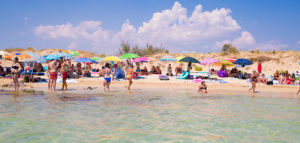If you stumbled across Culross on a summer’s day, you could be forgiven for thinking you’d wandered into a Dutch master’s painting. And you wouldn’t be entirely wrong. The charismatic, curiously foreign-looking Fife village could be the lost cousin of some far-away burgh; I was eight when I first visited, and can still remember my dad crouching to explain how the roofs of the buildings there, with their jagged edges and orange tiles, came to look so different.
The former port, one of the most complete examples of a 17th-century village in Britain, has a long history of trade with the Low Countries, Scandinavia, and the Baltics. But that summer my dad kept it simple — he pointed at the seashore and told me how, in the olden days, boats left there for France and Belgium loaded with Scottish coal and salt, and on their return brought back building materials, including those distinctive orange tiles that are still ubiquitous in Culross today. Later I’d hunt down the architectural terms to describe those Flemish influences: pantiles, crowsteps, gablets.
Culross suffered a very gradual loss of purpose. The harbour was filled in late in the 19th century, replaced by a rusted railway line and later a Pay and Display car park. In 1900, the village was described as “a decayed royal burgh containing many old houses”, and by the Eighties, when my dad first took me there, the place had been ghostly for decades — the water was quiet, the buildings were flaking and sad, nothing much moved but net curtains and chimney smoke. There was little life and definitely no chance of an ice cream.
Yet this small town boasted an illustrious history: it was one of Britain’s very first industrial villages. It owed its fine reputation to Sir George Bruce of Carnock (1550-1625), the engineer, merchant, MP and Privy Councillor who brought great wealth in the 16th and 17th centuries through exports of local coal and salt. Bruce earned the hamlet the title of “royal burgh” from King James VI in 1588, and went on to build the mustard-colour Culross Palace — his great lodging — which remains Culross’ most popular tourist attraction. By the time of his death, he employed 175 miners and owned 44 salt pans in the local area.
By far his greatest achievement was the Moat Pit — a coal mine under the sea. This wildly ambitious mining operation showcased Bruce’s skills as an engineer, 150 years before the dawn of the Industrial Revolution. The Moat Pit shaft, a watertight tower of stone projecting up off the seabed, was built 450m from the shore and allowed Bruce access to the otherwise unreachable coal reserves under Culross Bay. Extracted coal could be loaded from the artificial island of the tower onto waiting boats which then headed straight for England and the Continent.
The shaft was a phenomenal achievement, unprecedented in Britain, and it drew admirers from throughout the country. One visitor, the English poet John Taylor, wrote: “Neither in any travels that I have beene in, nor any history that I have read, or any discourse that I have heard, did neither see, read, or heare of any worke of men that might parallel or equivalent with this unfellowed and unmatchable worke.” Even Ben Johnson, the most famous writer in the country at the time, visited during his peregrination on foot across Britain between 1618-19.
The grandest person to brave the Moat Pit was King James VI, who made an excursion to Culross in 1617. Bruce led the King through the tunnels below the seabed and up onto the small artificial island of the Moat Pit shaft at high tide. His Majesty — no stranger to superstition at the best of times — climbed gingerly from the darkness onto a 15m-wide stone ring in the middle of the Firth of Forth, looked around despairingly at the expanse of wind-roughened water that surrounded them, and, bamboozled by what he no doubt considered some dangerous magic trick cried, “Treason!” Bruce assured the King that he was safe before guiding him to a tethered boat and rowing him back to shore. The pair then retired to the abbey for dinner and drinks.
Remarkably, the Moat Pit still exists. A storm overwhelmed the shaft and flooded the tunnels at the end of March 1625, the year of Bruce’s death, but the entrance to the sea tower — now a disc of seaweedy stone which protrudes from the surface of the water at low tide — is still visible if you know where, and when, to look. After his death, Bruce’s son continued to mine in the area, but he was unable to match the great entrepreneurial force of his father. By 1750 the boom in Culross was over, and the village entered a slow decline that lasted several centuries.
Visiting recently with friends and family, though, it was clear that the village I knew as a child is prospering once again. In an era of historical TV box sets and cosy Instagram reels, Culross’ time-capsule beauty is flowering; the houses are freshly painted, the cobbles are weeded, there are holiday rentals and shops selling wax melts and impractical pottery. The village features regularly in Sunday pull-outs and mainstream travel guides, and The National Trust for Scotland continues to diligently restore and maintain many of the historic buildings. Visitors who come for the history can refuel on coffee and cake, even ice cream from a van.
But what explains this unexpected renaissance? A decade ago, I had few Scottish friends who knew of the charms of Culross, despite growing up nearby. Today the village is marketed in a way that wasn’t possible in the Eighties: via social media; it is attracting a generation of tourists and content creators drawn to eye-catching locations off the beaten track. Tegan Carty, who works in a cafe opposite Culross’ implausibly photogenic Mercat Cross, has noticed this trend: “It’s mainly Americans and Spanish-speaking people, and they are just looking for something to see and do away from the big well-known cities like Glasgow and Edinburgh,” she says.
It’s not just the history and the scenery they come for: “They mention Outlander. It’s always Outlander.” The historical drama, the latest in a line of recent film and TV shows to use Culross as a backdrop, has won a legion of fans captivated by romantic storylines and creative remodelling of Scottish history. Many sites across central Scotland have enjoyed the same Outlander effect, including Doune Castle, 20 miles from Culross, which has seen visitor numbers increase by around 200% since filming there began.
The disruption in Culross hasn’t been quite so severe, and for locals like Carty there are more pressing issues than seasonal tourism: “I love working here, it’s a brilliant wee town. The only problem is you get no service on your phone.” But times are changing nonetheless. Bruce’s handsome, mustard-colour palace, for instance — one of Outlander’s main locations — now allows in only eight visitors every 15 minutes, in a bid to protect the building’s original wooden beams.
Historians can scoff at the selfie and ice cream crowd that visit Culross today, but the reality is that the twin magics of film and social media can lure visitors who would never otherwise come, and their presence, not to mention their cash, can often be a catalyst for further investigation and interpretation of historical sites. Once the crowds have arrived it is the stories, not the backdrops, that will capture their imaginations.
Disclaimer
Some of the posts we share are controversial and we do not necessarily agree with them in the whole extend. Sometimes we agree with the content or part of it but we do not agree with the narration or language. Nevertheless we find them somehow interesting, valuable and/or informative or we share them, because we strongly believe in freedom of speech, free press and journalism. We strongly encourage you to have a critical approach to all the content, do your own research and analysis to build your own opinion.
We would be glad to have your feedback.
Source: UnHerd Read the original article here: https://unherd.com/





